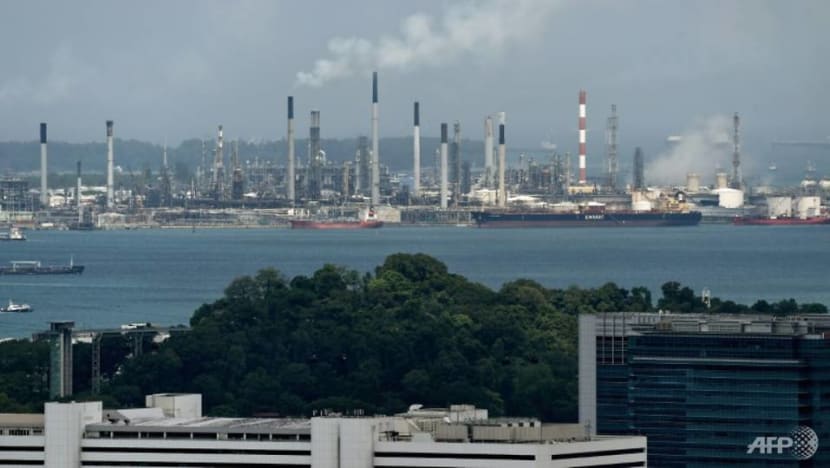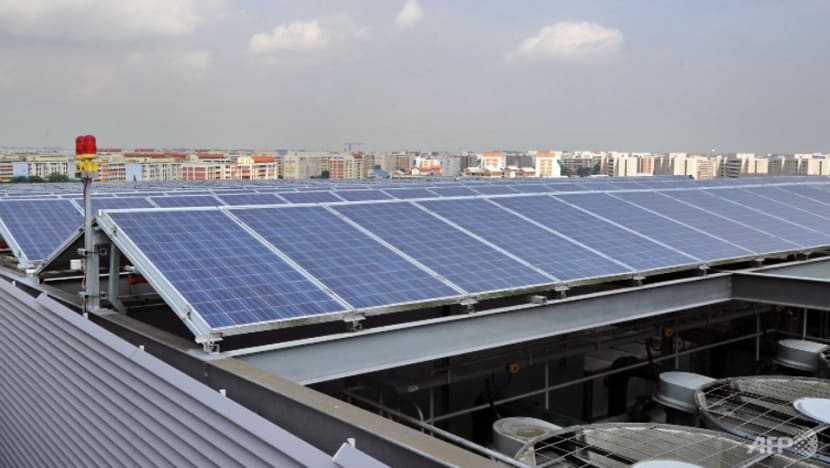commentary Singapore
Commentary: Carbon tax a conscientious approach for a sustainable future
Where the announced carbon tax rate at Budget 2018 has seen a downward revision from a previously mentioned range, two experts discuss the merits of an entry-level carbon tax.

Singapore is planning a carbon tax on facilities such as petrochemical plants. (Photo: AFP/Roslan Rahman)
SINGAPORE: There was a sigh of relief during Finance Minister Heng Swee Keat’s announcement at Budget 2018 that a carbon tax of S$5 per tonne of greenhouse gas emissions will be imposed from 2019.
In doing so, Singapore joins more than 67 other jurisdictions in implementing carbon pricing as a tool to reduce carbon emissions.
Since the 1990s when it was first implemented in most Nordic countries, a carbon tax has been progressively accepted as a transparent and accountable way of pricing in the cost of the negative externalities of producing energy, and collecting revenue from the large emitters of harmful greenhouse gases (GHG).
However, to most businesses and individual consumers, a carbon tax is a new and additional expense. They will have to integrate this new cost burden into their operating budget constraints.
Environmentalists may see the landing price point as marginal compared to the prices set in other countries such as Sweden and Norway, where rates go as high as S$186 per tonne of emissions.
Where it had been announced previously that the carbon tax might land at S$10 to S$20 per tonne of emissions, the price point announced at Budget 2018 was a downward revision.
What might be the reasons for this? More importantly, will it still achieve its intended impact in shaping business decisions and consumer behaviour?
OPPORTIUNITY TO ENHANCE CLIMATE CHANGE EFFORTS
Regardless of the imposed amount, Singapore’s carbon tax presents several opportunities to enhance national efforts in tackling climate change, including through more robust data collection and revenue recycling to help companies become more energy efficient.
Companies will be required to submit a verifiable emissions report by Jun 30, 2020.
Monitoring plans indicating how each company ensures the quality of data used for computation in the emissions report, which may have to be verified by an independent third party, will have to be submitted by Dec 31 in the year the company registers as a taxable facility.
Some of these guidelines were earlier introduced as part of enhancements to the Energy Conservation Act.

How carbon tax revenues are reallocated to the economy will be important.
A key question is how should these be allocated among the goals of driving further green investments and energy efficiency? In addition, how much revenue will be directed at fostering industry and job growth in the clean energy sector or in aiding companies working on sustainable urban solutions?
As Mr Heng mentioned, revenue collected from this scheme will be used for two existing funds designed specifically to support further green initiatives for the industry, going some way to help make progress in Singapore’s goal of sustainable development - one that manages our carbon footprint and does our part to combat climate change.
It is unclear if all revenue will be channelled indefinitely to these funds, but the option to use some revenue to drive other productive aspects of the economy such as infrastructure or education could potentially be open.
STARTING SMALL
S$5 per tonne of emissions may sound trivial to some. However, many countries that charge high carbon taxes often include exemptions to avoid the economy being struck too hard by carbon prices.
According to a literature survey of carbon pricing in 2016 by academic journal Energy Policy, Switzerland exempts the transportation sector, whereas France excludes the fishing industry in their system. Singapore, for now, does not view it necessary to employ such exemptions.
Other jurisdictions such as British Columbia and the Nordic countries are less affected by a carbon tax for electricity generation because they are almost entirely fuelled by cleaner renewable electricity sources such as wind and hydropower.

Like some of the more recent adopters of the carbon tax, such as Japan, Chile, Colombia, and Latvia, Singapore is starting with a low initial carbon tax rate. The S$5 per tonne of GHG emissions serves as an entry-level price to allow the economy time to adjust before the tax is increased after review by 2023.
As Joseph Aldy, an associate professor of public policy at Harvard Kennedy School, mentioned in a recent paper that the immediate implementation of a large carbon tax in general will “shock the energy system” and destabilise longer-term plans to attract support for the tax.
As a small open economy that has a sizable dependence on foreign direct investments and fossil fuels, Singapore must ensure that the cost from a carbon tax does not unduly increase the cost of doing business in Singapore, risking driving companies away or costing the economy jobs.
Currently, electricity generation for Singapore is still predominantly driven by fossil fuels, even though we’ve moved toward using cleaner burning natural gas. This means unlike some other developed countries, most sectors in the economy will be impacted by the tax.
DOES NOT RULE OUT CARBON TRADING SYSTEM
Looking at the draft Carbon Pricing Bill released late last year and to be read later this year, Singapore’s carbon tax is to be operated as a fixed price credit-based system, where covered entities purchase allowances from the regulator NEA and surrender the amount equal to their respective emissions during the compliance period.
Such a move allows authorities the flexibility to move towards a carbon trading scheme in the future, where Singapore imposes a cap on the total level of emissions, and allow companies with low emissions to sell their excess allowances to larger emitters.
Singapore’s 2030 target of reducing emissions intensity by 36 per cent compared to 2005 levels could act as a cap in such a trading scheme, where emissions based on this are expected to stabilise at 65 million tonnes of GHG emissions by 2030.

IMPACT ON MONTHLY HOUSEHOLD UTILITY BILLS
What looks certain is that household welfare is unlikely to be adversely affected – given that the resulting electricity and gas expenses from the carbon tax will only rise by about 1 per cent on average and additional Utilities-Save rebates will be provided by the Government to eligible households.
Another offsetting factor may be Singapore’s move towards full retail contestability in its electricity market by the second half of 2018.
Singapore residents could be looking at further discounts off their electricity bills compared to Singapore Power tariffs should they switch to a suitable alternative tariff plan or electricity provider, based on publicly available price offers and assuming oil prices and households’ electricity consumption remain similar.
READ: A commentary on the benefits of an Open Electricity Market.
In addition, consumers may be allowed to switch to providers who use renewable sources of energy such as solar power in the future, further reducing their carbon footprint.

ROAD TOWARDS SUSTAINABLE GROWTH
The new carbon tax is intended to price in the costs of climate change and our carbon footprint into energy consuming activities, making them more salient to businesses and consumers.
This complements existing educational and financing schemes in place to reduce our carbon emissions and combat climate change in Singapore.
Putting a price on carbon has proven reasonably successful in most countries that have implemented it. The carbon tax is thus an essential step in Singapore’s climate change efforts, and necessary if we are to meet our international climate commitments under the Paris Agreement.
Companies and consumers must use the next few years wisely to get a head start before authorities review the carbon tax rate with the intention of increasing it to between S$10 and S$15 per tonne of emissions by 2030.
We must aim to become more energy efficient and factor in the cost of climate change cost into our everyday lives, until it becomes part of our habitual nature to be mindful of our actions and how they impact the environment.
Allan Loi is a research associate at the Energy Studies Institute at the National University of Singapore. Melissa Low is a research fellow at the same institute.

















